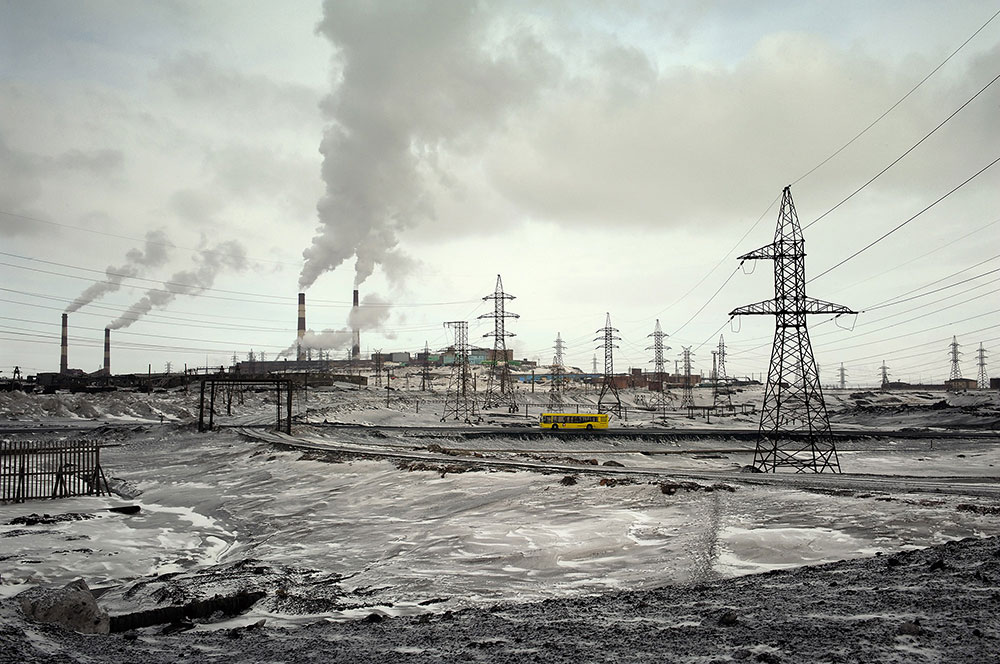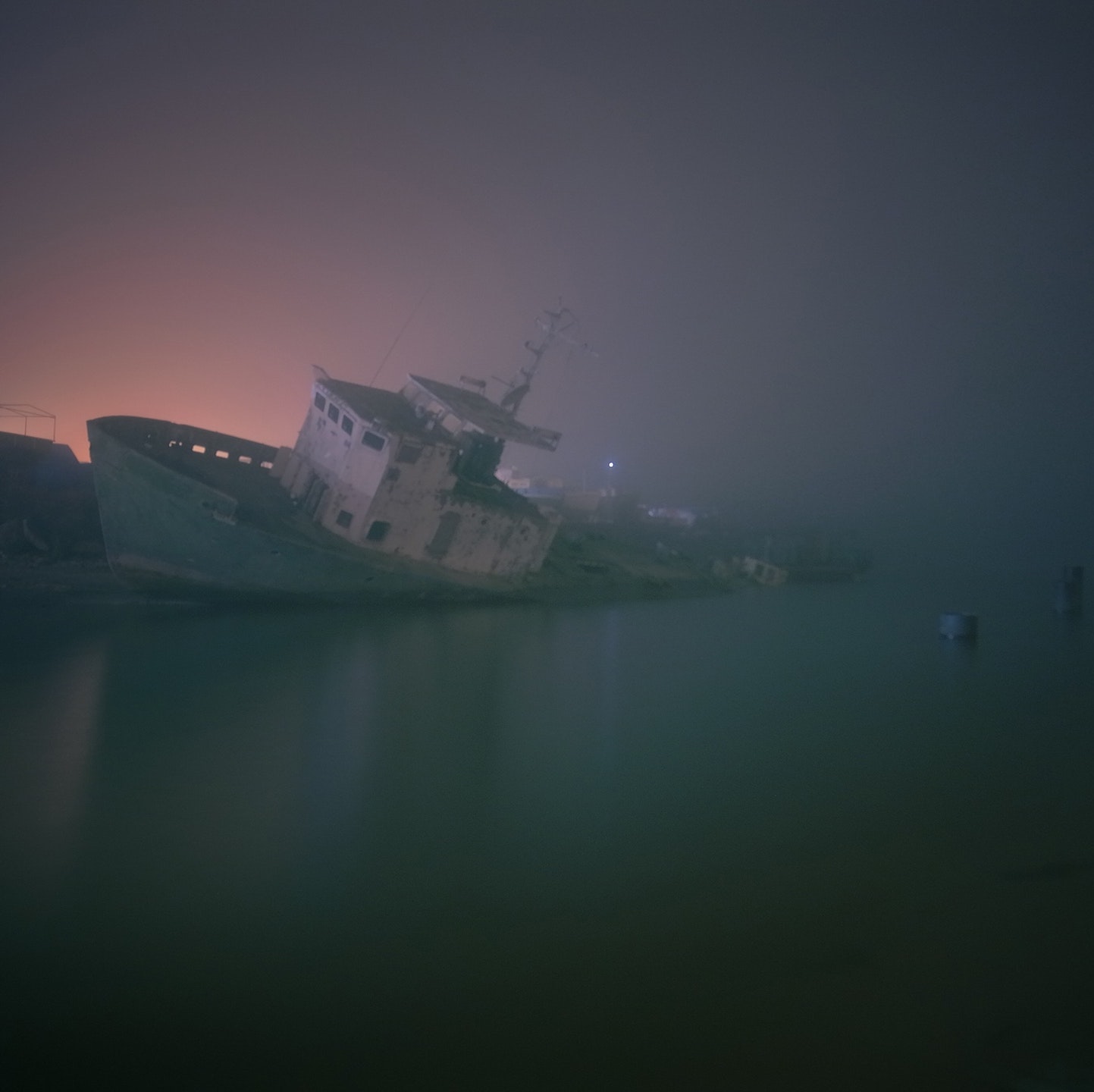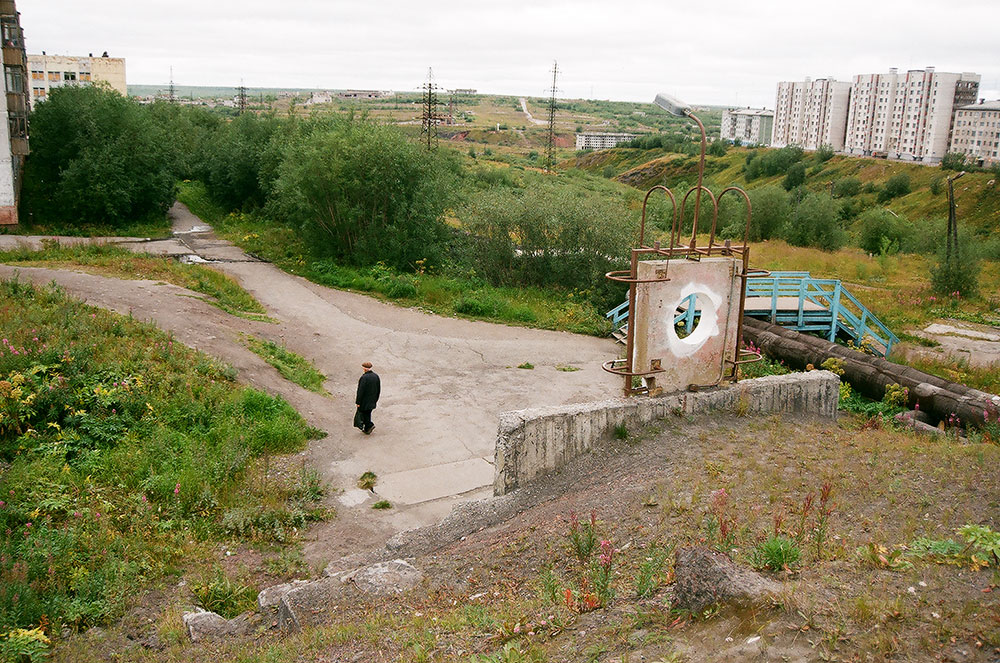Life above the Arctic circle: when the resources run dry, how will the people of the Kola Peninsula survive?
The Soviets set out to bring industrial prosperity to Russia’s Arctic towns. Today, many residential buildings on the remote, northwestern Kola Peninsula stand vacant as the factories power on. Mikhail Lebedev documents Kola’s workforce and forbidding polar terrain.
A series of concrete pillars poke out of the snow: likely the remnants of some unfinished construction that ceased when the USSR collapsed. The photo was taken by Mikhail Lebedev in a small industrial city situated beyond the Arctic Circle, and is part of a larger meditative series on the Kola Peninsula in Russia’s North. In their arrangement, the pillars recall the Soviet housing blocks and chimney stacks looming in the background — it is an Arctic city in miniature. Perhaps this likeness is the reason a passing local took pity on these nondescript protrusions, painting them bright pink in an unlikely gesture of care towards Kola’s built environment.
An accidental Arctic city in miniature
The Kola peninsula is home to giant industrial cities such as Murmansk, Nikel, and Apatity that thrived during Soviet times but have seen better days since. Over the last three decades, the peninsula’s population has been shrinking. A third of Kola’s population has already departed, yet where other mono-industrial Russian cities are struggling to keep factories open, production is still running across the region. In fact, Kola remains the most industrialised and urbanised area in the Arctic. But who are the people who live there?
“I am constantly searching for an answer to the question: what is Russia and who are the Russian people?” explains Lebedev. “This trip to the Arctic Circle has been one of the stages in this exploration.” The St Petersburg-based photographer set off to the peninsula earlier this April, renting a Niva jeep for two weeks and bringing along his hefty Hasselblad film camera.
Abandoned and residential buildings in the city of Kiro.
“I saw it as a personal challenge to drive 2000 kilometres through an unknown and desolate area by myself,” he reflects. During winter, local temperatures can drop as low as -50ºC, so Lebedev was glad to arrive to a moderate -10ºC. Still, weather conditions weren’t always pleasant. “After some time, it turned out the heater in my car was broken. I spent the rest of the trip in the freezing cold and had to keep my legs moving to keep them somewhat warm,” he says.
Another time, driving at night, the photographer was caught in a blizzard. “I had to slow down to 10-15 kmph, and all I was able to see was the tip of an endless snow bank on my right. The closest town was 30 kilimetres away and there were no gas stations, no shops, no roadhouses. I was surrounded by a lifeless snowy desert. Eventually another car caught up to me and the driver suggested that I drive after him. We were out of the blizzard in an hour.”
Orthodox Church and nickel ore processing plant in Nikel
Kola’s harsh, subarctic climate brings hardships, yet the region’s wealth of natural resources have led to successive developments: roads, large industrial complexes, and jobs. “This is a story about the relationship between mankind and nature. Sometimes she is our ally, sometimes our deadliest enemy,” Lebedev says. He admits that his work began as a project about people’s exploitation of natural resources — but the longer he spent on Kola, the more he realised it was a story about human resilience: “I was amazed by the courage, honesty, and strength of the people I met.”
The conversations he had with locals were often punctuated by sporadic moments of uncertainty for the future — worries about depopulation, resource decline, and global warming. “All of the cities are located around huge quarries and mines. Sometimes you get the feeling that people are nothing but biological attachments to these industrial machines. Just walking past abandoned houses or driving through endless frozen marshes, you can’t help put ask: is this place even suitable for life? What will happen when these resources run out?”
Antonina drives a 120-tonne truck at the Kovdorsky iron ore mine
Lebedev felt it was important to show the workforce behind the Arctic’s heavy industry. The series features engineers, machine operators, and managers who the photographer found on social media or through acquaintances. He says that the portraits in the project took the longest to arrange: “I’d meet the subject, we’d talk, drink tea, then start shooting. I was worried that the time it takes to set up the film camera would bother people, but in reality, it was useful for the protagonist to relax and feel more like themselves.”
His decision to use a medium format film came from the desire to bring a sense of gravitas to the topic. He wanted to print his photos of expansive white landscapes large enough so that viewers could immerse themselves in them. The idea helped to form the evocative name of the series, Snow Desert, although the portraits show life on the edge of the world to be anything but — at least for now.
Life beyond the Arctic Circle is unthinkable without heat and light
Some images have symbolic meaning, such as one photo of a house with a bright warm glow emanating from the windows. “At some point I realised I needed to have more images that posed questions. You need ambiguity: an image that conveys everything and nothing at the same time,” says Lebedev. He came across the house one evening while exploring Murmansk. At the time, he was uncertain whether to shoot everything he encountered. It was only on his return to St Petersburg that he found his interpretation of the image: “It is about warmth and light. For me this photo is a metaphor for life amid brutal conditions. The Kola peninsula has a special relationship with light. In summer the light is ever present, but in the winter the sun skirts just below the horizon. During this time, any artificial light can drive away the darkness.”
As for his investigation into what it means to be Russian, Lebedev says: “Years of exploring the topic with photography has taught me that there is not one Russia. Russia is a multitude of universes.”


